Motorcycle Helmets That
Protect Your Melon
And Look Good Doing It
Motorcycle helmets are the best way to protect your head in case you’re ever in a motorcycle crash. And as they say (whoever "they" are) it's not a question of if you crash, but when.
Whether or not you wear a motorcycle helmet when you ride is a matter of personal choice, and can be a prickly issue to discuss with some riders, especially here in the US. For me, it’s a no-brainer; I always wear a helmet when I go out for a ride... unless it's just up and down the driveway. (I'm an excellent rider, definitely).
Some states have motorcycle helmet laws requiring riders and passengers to wear a helmet, and often it depends on the person’s age. The American Motorcyclist Association (AMA) keeps a
list of motorcycle helmet laws by state.
So, after you've decided you want or need to wear a helmet, what's the best motorcycle helmet for you? You’ll have to make that decision for yourself, but this page and related links will serve as your guide to making a smart choice.
Check out what Scorpion Helmets Have to Offer
Helmet Types
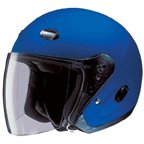
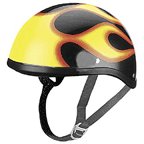
Open-face helmets like the ones shown above are the most basic type of motorcycle helmets. And as the name suggests, your face is exposed when you wear them. This includes ¾ helmets, which protect the top, back and sides of your head and half-helmets, which give protection for just the top and part of the back. These are popular with people who ride cruiser motorcycles.
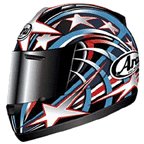
Full-face helmets are easily identified by the chin bar that covers the jaw area. These are the most protective helmets because, well, they cover your face, which could be pretty important if you have an unscheduled get-off. They have a series of vents to keep you cool in the summertime and many models offer removable/adjustable padding so you can get a perfect fit and remove it for washing. Many models like the one above by
Arai Helmets
are available with racer replica graphics (MotoGP star Colin Edwards, in this case).
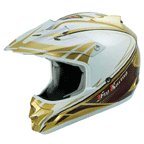
Dirt helmets are for not only motocross riding these days, but are popular with owners of Dual-sport machines. These street-legal bikes are off-road capable and the dirt helmet with a pair of goggles looks the part as well. Dirt helmets are a type of full-face helmet, but typically there is a visor (which can be removable) and no face shield since a pair of goggles is typically worn.
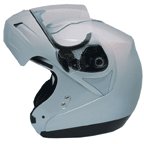
Flip-front helmets (aka modular helmets) attempt to offer the convenience of an open-face helmet with the added protection of a full-face design. You just push a button and flip the entire front of the helmet up and out of your way. A friend of mine let me try his and it was pretty interesting. It seemed to be a nice compromise between safety and convenience. I'll still be sticking with full-face designs for now, but down the road, who knows? I'm still not quite convinced that the level of safety is up to what a full-face helmet gives you. And so far, Snell (see section on Safety Certifications) has not given their approval to any flip-up motorcycle helmet designs.
Motorcycle Helmet Construction
Think of a motorcycle helmet as an energy dissipation system, because that’s exactly what it is in a crash. It is designed to deform on impact and absorb as much energy as possible before the blow is delivered to your head.
IMPORTANT: Helmets are designed to protect against a single impact. Once deformed from a hit, the EPS liner (see below) in your helmet doesn't bounce back and therefore can't absorb much impact energy and won't protect you anymore. If your helmet is subjected to a significant impact you should discard the helmet and replace it. (HJC Helmets says a drop from about 4 feet is enough to warrant replacing the helmet).
Shell: The shell is designed to spread the energy of an impact over a large area in order to minimize the energy that reaches the rider's head. It also has to be abrasion and puncture resistant. The helmet shell is typically made from fiberglass, some sort of polycarbonate plastic (similar to what CDs are made out of), and increasingly materials such as Kevlar and carbon fiber are being used.
EPS liner (expanded polystyrene): This is the energy absorbing material just beneath the shell. The shell is typically made from fiberglass or polycarbonate plastic (tough plastic like CDs are made out of). The idea is that the shell spreads the force of impact over as wide an area as possible and the EPS liner compresses to cushion the blow to your head.
Inner comfort liner/padding: This is the foam padding that fits the helmet to your face. Some modern helmets have removable padding so it can be washed. A few have different padding thicknesses or even inflatable air bladders to offer a custom fit.
Chinstrap: Obviously, this is what helps keep the helmet on. There are different styles of chinstraps, with the "double D-ring" being the most popular and most secure. Other quick-release designs have come out to make it quicker and easier to remove. These typically have plastic latches that maintain a decent level of safety, but could conceivably break in an accident or with repeated use. Generally, they are regarded as safe.
Visor: Many helmets have a visor included to keep the wind and bugs out of your face and eyes. Some clever designs include features to open the visor a smidge to aid ventilation and prevent fogging. Quick release features allow face shield removal for cleaning or swapping out a clear shield for a tinted one, for example. They also need to be scratch resistant.
Vents: Some helmets have vents to allow air to pass through the helmet to keep your head cool and even to keep the visor from fogging.
Safety Certifications
In the US, you’ll find two certification seals for motorcycle helmets: The DOT and Snell.
DOT refers to the US Department of Transportation, of course, and they require that motorcycle helmets pass a series of tests before they can be sold in the US. The tests involve dropping the helmet from a certain height onto steel “anvils” of different shapes and are meant to simulate what might happen in an accident.
The Snell Memorial Foundation is an independent non-profit organization dedicated to help increase the safety level of many types of helmets. They perform tests that are similar to the DOT test regimen, but they have their own criteria for motorcycle helmet certification.
Recently, there has been some controversy about whether or not the Snell standard makes helmet manufacturers produce helmets that are too stiff and therefore allow excessive G-forces to reach the rider’s head. This is due to the fact that they require two strikes from the anvil in the same location, which is a pretty difficult task. This isn’t a simple issue, and it came up after Motorcyclist Magazine published an article on helmet safety standards. I recommend that you read their helmet safety article for more information. The article does show that you don’t have to spend a lot to get a safe helmet. Although, you will tend to pay more for helmets that have more features.
Fitting Your Next Lid
When shopping for your next helmet, take the time to make sure you buy one that fits properly. Even if you’re replacing a helmet with one from the same manufacturer, there’s no guarantee it will fit the same or that you got it right last time. Here’s how to make sure your helmet fits right:
- Measure your head with a flexible fabric tape just above the ears and eyebrows. (If you have a friend that can help with this, it will be easier to get an accurate measurement). The good thing is that the major helmet manufacturers have a consistent sizing scheme based on head circumference. Of course, that’s not the whole story since heads come in different shapes as well as sizes. Check the sizing chart to find what size helmet you should start with.
- Now that you have a starting point for size, try on your prospective lid. Do this by holding it upside-down so the front faces you. Grab the chinstraps with your thumbs on the inside and flip the helmet on your head. The helmet should be tight enough so you need to tug outward on the straps slightly to get it down over your head. If not, you should go down a size.
- Once the helmet is on, fasten the chinstrap as tightly as possible (without being painful). It should be snug without being uncomfortable or painful. There should be no pressure points. If the helmet is too big, it may contact only the top of your head, which will be uncomfortable after a while. If the shell is the wrong shape for your head, this may also cause pressure points.
- Try to stick your fingers between the helmet and your forehead. The helmet should fit evenly and you shouldn’t be able to get your finger between the helmet and your forehead. For example, my old spare helmet always gave me a pressure point in the middle of my forehead, which was uncomfortable after a while. It fits tightly in the middle of my forehead, but there are gaps at the sides.
- Grab the helmet by the sides and try to rotate the helmet left and right while holding your head still. Your face should move with the padding of the helmet as you do this. If the padding slides, the helmet is too loose. You either have to go down a size or replace the cheek pads with thicker ones if that’s an option.
- Retention test – Grab the back edge of the helmet and try to pull it off over your head. If the helmet comes off (or nearly does), try a smaller size. Snell tests helmet retention by attaching weights to the helmet with a cable and dropping them from a certain height in an attempt to roll the helmet off forward and backward in dynamic tests.
Top 10 Motorcycle Helmet Tips:
1. Actually wear a helmet (and consider making it a full-face design) when you ride! You'll enjoy the ride more without the wind blasting you in the face and making your eyes tear as it whips around your super-cool Oakley sunglasses. Wearing a helmet will keep you more aware of your surroundings by keeping distractions out. Go ahead and wear the Oakleys, but put them under your motorcycle helmet.
2. Proper fit is everything. If your helmet isn’t comfortable, you aren’t as likely to wear it and it’s not going to do you much good sitting on the closet shelf. Make sure you go through the fitting procedure and don’t assume you know what size you need.
3. Certification. It bears mentioning again that your helmet should at least have DOT certification if not dual DOT and Snell certification for safety. Helmets for sale in the US must at least carry the DOT stamp, although there are non-DOT helmets for sale and have disclaimers that they aren’t designed to protect you in a crash. What good is that?
4. Choose a bright-colored helmet. It’s hard enough to get the attention of drivers out there since half of them are talking on the phone (or worse, texting) while driving. It’s a good idea to do what you can to draw attention to yourself when riding. Your head is the highest and most visible part of you when you ride, so that’s a good place to start.
5. Don’t look for a cheap motorcycle helmet just for the sake of saving money. Your brain is worth a reasonable investment. You can get quality discount motorcycle helmets from some online dealers, but you don’t really want a “cheap” helmet.
6. You don’t need to overspend. This may seem to contradict #5, but a $500 helmet doesn’t necessarily protect you any better than a $200 one. Although, you may choose to invest the extra money to make sure you get the features you want.
7. Wear earplugs when you ride. You’ll see companies saying their helmets are “quiet”, but what does that really mean? There’s no standard for quietness, and airflow and turbulence have a lot to do with the kind of bike you ride. It’s always going to be pretty loud inside a motorcycle helmet, so you should do what you can to protect your hearing. I recently started wearing earplugs when I ride and it doesn’t diminish the experience or keep you from hearing what you need to. It just takes the edge off the wind noise, which will basically make any helmet “quieter”.
8. Replace your helmet about every 5 years. The materials degrade over time and you should definitely keep your head protection “fresh”. I’ve been guilty of keeping helmets around too long and honestly, if the comfort liner is any indication, the thing needs to be retired!
9. Keep your helmet fresh: consider wearing a helmet liner. It keeps the oils and sweat from your head from fouling up the helmet padding. Even if you have removable helmet padding, who wants to mess with that if you don’t have to? There’s also a spray called “Helmet Fresh” to help spruce things up.
10. Never buy a used motorcycle helmet or even accept one that a friend might be giving away. It’s always better to get a fresh new one that is fitted properly for your individual head. Besides, you don’t know what that other helmet has been through and it’s kind of gross to be wearing a helmet that someone else has sweated in!
Return from Motorcycle Helmets to Everything Motorcycle Homepage